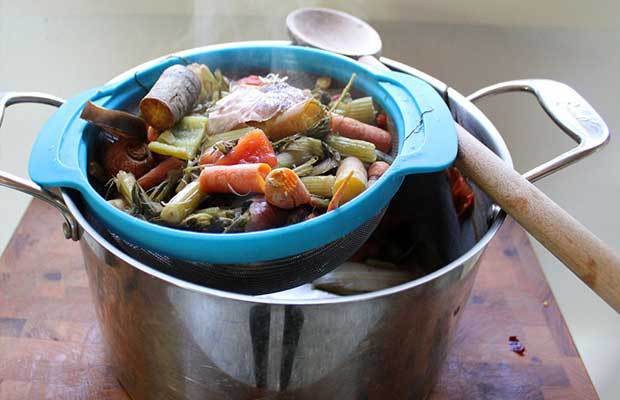I’m one of those people who really loves soups and stews. A good soup simmering on the stove makes a house feel like home, it offers comfort during stressful times, and it warms you through and through when it’s bitterly cold outside. In addition to all that–soups offer lots of health benefits since they’re typically made with fresh, low-fat ingredients, contain a minimal amount of salt and extra fats, and provide vitamins like A and C. And since nothing makes a great soup like a good stock base, I’ve long-since learned to make my own DIY broths to use in my soups and stews.
Hint: Making your own broth doesn’t have to cost extra; each time you peel or trim vegetables put the scraps in a zip-lock bag in the freezer rather than adding them to your compost bin. Vegetables store the majority of their flavor–not to mention a host of vitamins–in their skins, so they make superior broths.
The Lost Ways is a far-reaching book with chapters ranging from simple things like making tasty bark-bread—like people did when there was no food—to building a traditional backyard smokehouse… and many, many, many more!Watch the video:
What to put in your broth
You can use practically anything to make a delicious broth–from the traditional to the unusual–making soup lends itself to experimentation, so feel free to get creative and try new things. Save celery leaves and ends, potato and carrot peelings, mushroom and garlic bits, the outer cabbage leaves, lettuce and other greens, uneaten bits of corn, peas, mashed potatoes, squash, rutabaga, beans, rice and other grains–they will all add valuable nutrients and flavor.
The same goes for meats–each time you serve a roast, put the bones, skin and fat trimmings into a designated freezer bag for later use. Or use the most inexpensive cuts to make a beef broth, use the bones of a roasted chicken, or save the meaty ham bone from your traditional baked ham dinner to make the best pea soup ever! Be sure to save the broth in the bottom of your roasting pan to add to the mix when you are ready to make your meat-based broth.
How to make the broth
I like a good pea soup once in a great while, so I save the bone from a baked ham for just such an occasion!
When you have saved enough scraps to make a good batch of broth place everything in a large stock pot, fill with water and cover. Bring the stock to a boil for the first few minutes to ensure that any bacteria is killed, then reduce the temperature to a simmer.
Simmer your stock at a low temperature anywhere from 6-8 or 12-24 hours. The larger the bones the longer you should cook them, until all the marrow and flavor has been extracted. Then strain the broth to remove then bones–remove any meat remaining on the bone or bones and save for later; for a vegetable broth you will again strain to remove the vegetable peelings, then put the stock through a sieve to remove any remaining bits. At this point I prefer to put the stock back into the pot and continue to simmer the broth to boil it down, which intensifies the flavor–but this is a personal preference and optional.

Place everything in a large stock pot, fill with water and cover
Storing your homemade broth
Once you have achieved the desired flavor with your broth or stock, remove it from the heat and allow it to cool completely before storing. You can keep your broth in the refrigerator for 2-3 days, or store it in quart-sized zip-lock bags and freeze it. You can even can it to preserve it long-term, and keep it in your pantry or cold-storage facility for later use.
Conclusion
Making your own broth is a great way to save money; by re-purposing those discarded kitchen scraps you’ll be able to stretch your food budget even further. Not to mention you’ll have some fabulous broth to make fantastic meals with when you’re finished. Start saving your kitchen scraps today and give it a try!
Have you made your own broth before? Have any tips, tricks or hints you’d like to share? Feel free to leave a comment below!






This method also makes your daily cooking easier… I like my carrot and celery pieces to look pretty and uniform and it gets harder to slice them when you get to the ends. When you slice to the desired amount, throws the rest in a ziplop bag in the freezer. I also freeze all of my parsley and dills stems and use them all winter to make broth.